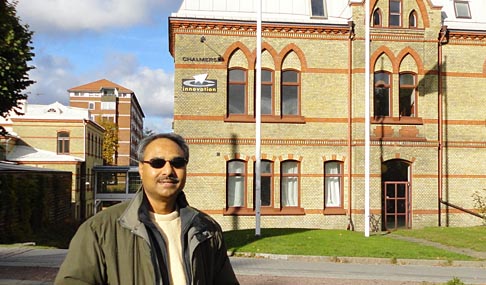“Hej till du från Sweden! Hur mår du? Mycket bra, ja!”
(Hello to you from Sweden! How are you? Very well, yeah!)

Dr. Abdul-Majeed Azad posed for a photo on the campus of the Chalmers Institute of Technology in Gothenburg, Sweden.
Chalmers is a 180-year-old private school of international repute in engineering and technology. Its engineering and applied science departments are well-respected in Europe and around the globe for their entrepreneurial niche.
The Division of Energy Technology, to which I’m attached for nine months as a Fulbrighter, is spearheading a clean energy manifesto with its world-renowned program in chemical looping combustion (CLC) and chemical looping via oxygen uncoupling (CLOU) processes. The program brings perhaps the world’s finest team of faculty, researchers and Europe’s brightest PhD students together. Thanks to Europe’s and Sweden’s obsession with the environment, CLC is well-funded by the European Union, Swedish Science Foundation and industrial energy giants that include Vattenfall. The CLC group also has well-established collaborations with similar groups in Spain, Austria, France, Belgium and Norway.
I’m certainly indebted to the Fulbright Commission for this wonderful opportunity. I consider myself very fortunate to be associated with such timely activities at Chalmers. I’m trying to synchronize my materials background with their exemplary expertise in large-scale fluidized bed reactor engineering that caters to power generation to the tune of 100 to 1,000 kilowatts-thermal, using fossil fuels in the most benign and cleanest possible way with the most sensible scheme of sequestering carbon dioxide from stationary power plants. It is Chalmers’ technological innovations coupled with its people’s passionate devotion to doing things right that I find not only fascinating but contagious, too. I hope this invigorating fervor stays with me.
Besides my work pertaining to the design and fabrication of the next-generation oxygen carriers, I’m also observing the pattern of rich ethics and healthy lifestyle that this nation has adopted. Some of the things I’ve fallen in unconditional love with in Sweden: the innate habit of recycling, passion for climate and its preservation; almost nonexistent waste of food; sense of keeping things in order; an uncannily efficient public transport system; and an almost religious addiction for “fika” (coffee with pastry, cookie or cake several times a day). And yet I’ve not spotted Starbucks peppered around! I can’t seem to find one obese person in Gothenburg!
Sweden’s population is a little more than 9 million — smaller than Belgium’s and more sparsely populated than Brazil. On a more familiar scale, it is about as big as California with a smaller population. It is also among the countries of the world farthest removed from the equator. And that for me where the Swedish fascination begins, with its shortest days (only few of them bright and sunny) in winter and the longest ones in summer.
Stockholm, the capital of Sweden, is the most beautiful city in Europe. It consists of several tiny islands, each telling a history of its own. It represents the perfect amalgam of Sweden’s mystifying Christian old and the modern. Thanks to the Fulbright Commission’s periodic summons for pleasant excursions and sightseeing, the more I go there, the more intense my infatuation with the city grows.
I’m resolved to learn more about Sweden and her culture as I slowly explore its landscape, interiors and borders with Norway and Denmark during the remainder of my stay.
Among many things I’ve experienced so far, one thing that has touched me most and will perhaps remain vivid in my mind’s eye forever is the Nobel Prize Award ceremony. As Fulbright grantees, we were invited to be part of this year’s event in Stockholm’s most impressive concert hall on Dec. 10.
There were 1,350 guests — including the Swedish Royal family, many heads of states and ambassadors — all in their best attire: It was no doubt the Golden Globe event for the best minds on this planet. The ceremony was not only a once-in-a-lifetime experience but also a very humbling and moving one. The ambiance was serene yet electrifying, soothing yet energetic. Above all, there was an unmistaken humility. It felt as if the divine kindness had descended on Stockholm that evening. And the audience savored every moment of it. Then there was one moment when time almost froze — or so it seemed — for an eternity.
When Professor Richard Heck’s name was called as one of the three Nobel Laureates in Chemistry, he slowly stood up but had difficulty walking toward the king to receive the honor. As if on an impulse, Professor Andre Konstantinovich Geim, this year’s Nobel Laureate in Physics, stood up, held Professor Heck’s elbow gently, and helped him walk. After Professor Heck had received the honor, Professor Geim helped him back to his seat with utter respect and deep reverence. Everybody watched with rapt admiration at what unfolded on the Nobel podium. The standing ovation from the audience was part congratulatory and part admiration of Professor Geim’s fine “Nobelity.”
Many of us later confided to one another that this humanistic gesture by Professor Geim brought mist of joy to our eyes. This made me think. Beyond the gold medal, citation and seal of immortality for individual genius, the true legacy of Alfred Nobel is to celebrate the best in mankind, irrespective of its source and background, and to raise the innate selflessness of fellow humans to surpass the ranks of angels. And in this legacy is the shining example of Sweden.
Azad is a professor in the Department of Chemical Engineering and a 2010-11 Fulbright Distinguished Chair in Alternative Energy at Chalmers University of Technology in Gothenburg, Sweden.